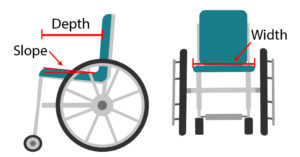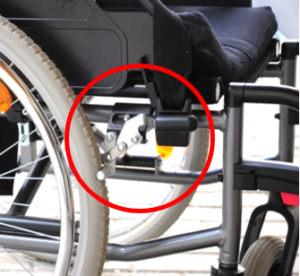Author: Sharon Jang | Reviewer: Emma M. Smith | Published: 3 March 2020 | Updated: ~
Manual wheelchairs are a type of wheeled mobility device that are an important part of independent living after spinal cord injury (SCI). This page provides an overview of manual wheelchairs. SCIRE Community is not affiliated with and does not endorse any of the specific products mentioned on this page.
Key Points
- Manual wheelchairs are typically used by people with enough movement control and strength in the arms to propel the wheelchair independently
- A manual wheelchair consists of many different parts, most of which can be altered to suit your needs
- Manual wheelchairs can be adjusted to prevent injury and to promote comfort
- Multiple factors play into injuries related to manual wheelchair use, including the way you push your wheelchair, your wheelchair set up, and the surfaces you are wheeling on
Manual wheelchairs are wheelchairs that are propelled by the user or pushed by another person. They do not have a battery or other power source.

For the most part, manual wheelchairs are used by people who have enough muscle control and strength in their arms to propel the wheelchair forward on their own. For people with SCI, this typically means that a person needs to at least have function of the biceps (the muscle that bends the elbow), which is intact for people with complete injuries at C5 and below. However, it can be difficult to propel a wheelchair for individuals with C5 and C6 injuries, so only some individuals with these types of injuries will be able to do so. Use of a manual wheelchair is more common in people with control of the triceps (the muscle that straightens the elbow), which is intact in people with complete injuries at C7 and below. In some cases, a manual wheelchair can be pushed by another person or propelled using the legs.
As a bridge between the more common manual and power wheelchairs, power-assist add-ons combine features of manual and power wheelchairs to provide greater assistance for those who need it. Additionally, non-powered propulsion assist add-ons may also be used to facilitate wheeling. Propulsion assist options are available for manual wheelchairs and come in several different styles. The use of powered add-ons has been reported to improve efficiency and to reduce strain on the cardiovascular system. The following article will focus on manual wheelchairs that are propelled with the arms.
Refer to our chapter on Propulsion Assist Devices for more information!
A typical manual wheelchair contains a frame, seat with a backrest, footrests or footplate, two small caster wheels in the front, and two large rear wheels at the back. The rear wheels contain hand rims which are used to propel and maneuver the wheelchair. Wheel locks on the rear wheels help prevent the wheelchair from moving when it is not in use or when getting in or out of it.
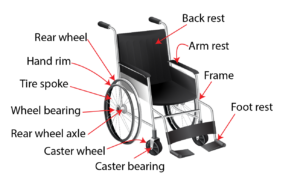
There are many different styles of manual wheelchairs, most of which allow for the ability to adjust and change aspects of the set up. This can be important in the first few years that a person uses a wheelchair as a person’s skills and priorities may change. Nonetheless, it is important to try to get as lightweight and compact a wheelchair as possible while also ensuring it is safe, durable and flexible.
There are many different components of manual wheelchairs that can be customized and changed to find the best set-up for an individual. Below, we list some of the common options and changes that may be possible when setting up a manual wheelchair. In general, changes to the set-up of the manual wheelchair are a series of tradeoffs. Although changes are usually intended to achieve a desirable improvement (such as greater ease of wheeling), sometimes they need to be balanced with reduced stability and an increased risk of tipping over. Please speak to your health providers before making any major changes to your wheelchair set-up.
Frame design
Manual wheelchairs come in two basic frame designs, folding frames or rigid frames. Folding frames have a crossbar under the seat that allows the frame to fold in half. Rigid frames may also fold but in a different way, where the backrest folds down. In many manual wheelchairs, wheels can removed if they are being put in a vehicle.
Folding manual wheelchairs
 Folding wheelchairs are designed to be folded vertically and take up minimal storage space. This allows for easy portability (such as fitting the wheelchair into a car). However, these wheelchairs also have many moving parts that may break down or loosen over time, and are heavier than rigid wheelchairs. Folding wheelchair often have flip up, swing away or swing in footrests so they may be used by individuals that do not use the wheelchair full time, can stand or take some steps, or by those who foot propel.
Folding wheelchairs are designed to be folded vertically and take up minimal storage space. This allows for easy portability (such as fitting the wheelchair into a car). However, these wheelchairs also have many moving parts that may break down or loosen over time, and are heavier than rigid wheelchairs. Folding wheelchair often have flip up, swing away or swing in footrests so they may be used by individuals that do not use the wheelchair full time, can stand or take some steps, or by those who foot propel.
Rigid manual wheelchairs

Rigid wheelchairs tend to be lighter and more durable than folding wheelchairs, which makes them the common choice for people with complete SCI injuries. The rear tires often have to be removed to fit into a vehicle because they cannot fold inward. Some rigid manual wheelchairs can still be ordered with adjustability, which can be important if seating components change.
Frame materials
The majority of manual wheelchair frames are made of either aluminum or stainless steel. Ultralight and sports wheelchairs are often constructed from high performance aluminum, carbon fiber, chromium-molybdenum, nickel alloy steel, or titanium. Titanium and composites can be considerably more expensive but are more lightweight.
Seat width, depth and slope
It is important that the width, depth and slope (also known as dump) of the seat from front to back are well-fitted to the overall function and characteristics of the user. A wheelchair that is too narrow in width may cause skin problems due to rubbing, while a wheelchair that is too wide may hinder propulsion, and will interfere with the accessibility and maneuverability of the chair. A wheelchair that is too short in depth may provide insufficient support to the hips and stability to the bottom, while a wheelchair that is too long in depth may cause knee pain or a slouching posture. In addition, an increased seat slope (i.e., one that is higher in the front than the back) makes transfers more difficult as one would need to lift up at an incline, but are better for people with a higher level of injury because this slope helps them find balance and stability to wheel.
Footrest angle and frame taper
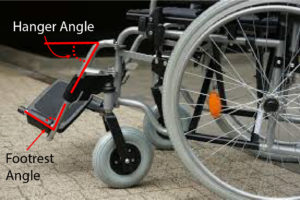
The footplate is angled away from the frame of the chair and the post of the casters.6
When considering the footrest angle between the seat and the footplate hanger, the knee flexion range of movement and hamstring length needs to be considered as well as the visual field as the client may not be able to see their feet. For example, a greater frame angle improves wheelchair access by making the chair shorter but may make the chair more unstable in the forward direction. Some wheelchairs have a frame taper, which is the narrowing of the frame towards the front and continues down to the footplates. This improves access from the front of the wheelchair, making toilet transfers easier. However, the taper may not be compatible with the cushion and may impact the ability of the wheelchair to fold.
Rear Wheels
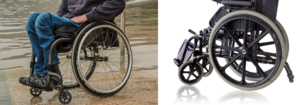
Spoked wheels (left) versus mag wheels (right).7,8
The rear wheels are set up with hand rims on them so that self-propelling is possible. Wheel material and the amount of air in the wheels affect how effective the wheels are in minimizing vibration or shock to prevent triggering of spasticity and to increase comfort. Wheel rims are made from a variety of materials including aircraft grade aluminum, plastic, fibreglass, reinforced nylon, titanium, carbon graphite, or steel. Types of rear wheels include: spoked wheels (made of metal, normally has more than 30 spokes), mag wheels (made out of synthetic material, less than 10 spokes), carbon-graphite mag wheels, and power assist wheels. The more spokes, the better the vibration absorption. The most common wheel size for adults is 60cm (24”) and for children it is 50cm (20”).
Tires
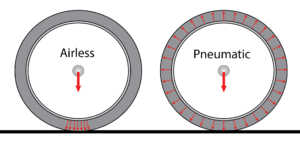
Airless (solid) tires tend to provide bumpier ride.9
Wheelchairs may have solid tires, foam-filled tires, or air (pneumatic) tires. Solid tires do not run the risk of popping, however, they often result in a bumpier ride. On the contrary, air tires provide a softer ride, but require regular maintenance of air pressure. A lack of air in the tires (less than 50% of the recommended PSI) makes propelling a wheelchair more difficult. It is recommended that tires be re-inflated every two months to keep the pressure above 50%. Some type of tires include: standard pneumatic tires, high pressure pneumatic tires, outdoor pneumatic tires, puncture proof tires, and solid plastic tires.
Hand rims/Push rims
Hand rims are attached to the rear wheel rim on wheelchairs that are intended for self-propulsion. This part is optional, and some users may opt not to use them. Hand rims are commonly made out of aluminum, and may be anodized or vinyl coated. Some downsides to using aluminum hand rims are that they may turn your hand black, and can become very sharp if they are damaged. Other models of hand rims have a rubber like material and assist individuals without full handgrip with their push stroke. In addition, flexible hand rims have been developed to adapt to the shape of the hand in order to reduce strain resulting from the bending action of the wrist and fingers.
Front caster wheels
The small front wheels are called caster wheels, and they help maneuver and steer the position of the wheelchair. Caster diameter, material, and position are important factors to consider that affect wheelchair balance and performance. Sizes available include 75mm (3”), 125mm (5”), 150mm (6”), 180mm (7”), 200mm (8”), and 250mm (10”). Bigger caster wheels are more stable, have a bigger turning radius, and easier to wheel over thresholds but are less maneuverable and responsive. A point of caution is that when caster wheels are trailing, a person’s weight will be more forward and may be in front of the caster wheel, which can cause tipping and is a frequent cause of falls in manual wheelchairs (see image below). Caster stem angle must always lie at right angles to the floor to ensure casters track correctly, or they may “flutter” when the wheelchair is pushed or can cause the front of the wheelchair to rise and fall during turning.
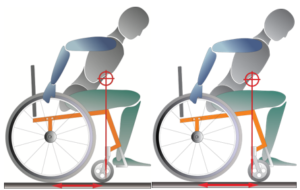
Forward casters (left) versus trailing casters (right).11
When choosing the type of caster, one should consider the most common type of surface they will be propelling on (e.g. outdoors or indoors), the desired front seat height, and the front frame angle of the wheelchair. The construction materials available for caster wheels include plastic, urethane and aluminum. Pneumatic caster tires, usually 150mm (6”)” and 200mm (8”) in diameter, have more shock absorption features making them ideal for outdoor wheeling, while 75mm (3”) and 125mm (5”) urethane caster tires are more common and are good for indoor propulsion and sport specific wheelchairs. Those who experience significant spasticity and/or discomfort when propelling wheelchairs often opt for pneumatic casters to achieve a smoother ride.
Wheel locks
Wheel locks are used on the large rear wheels for safety with transfers and when no movement is wanted. They vary in styles including push to lock, pull to lock, and scissor style locks. To decrease the force required to engage/disengage the wheel locks, extended brake levers can be applied, as they minimize the forward reach required to access the wheel locks. The type and position of the lock should be influenced by the user’s reaching ability, balance, strength, and hand function as well as the impact of wheel lock position on transfers. Some clients with good physical skills may not even require wheel locks at all.
Anti-tippers
Anti-tippers are an optional set of smaller wheels connected to a metal poles that are attached to the frame of your wheelchair 381 to 508mm (1.5 to 2″) above the ground. Anti-tippers are commonly found on rear of the chair to prevent a backwards fall, however they can also be found on the front of the wheelchair to prevent forward tipping. Anti-tippers may be especially useful for new wheelchair users, those who have recently switched to a new wheelchair, or if one’s health is declining. While they are considered a safety item, they also have drawbacks. Firstly, anti-tippers may interfere with wheelchair skills requiring you to lean backwards, such as climbing a curb or doing a wheelie. Secondly, if the anti-tippers are set too low, it may impede on going over obstacles or up hills.
There are many necessary considerations for setting up a manual wheelchair properly for mobility and function. It is important to work with a knowledgeable health care professional and vendor to ensure the correct decisions are made.
These considerations may include:
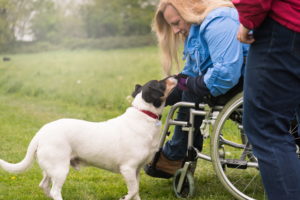
Various factors can influence your ideal wheelchair set up. In this photo, some considerations include having a dog and wheeling on grass.13
- Activities of Daily Living: It is important to think about where you need to take your chair, how close you can get to or under surfaces, reach for things, and how easily you can remove components and put them back on.
- Mobility: You need to consider what surfaces you will wheel on (carpet, flooring, snow, rain). How the chair will move over inclines and transitions as well as in confined spaces. Is it a primary chair or just an indoor chair or a transport chair?
- Positioning: It is important to consider your posture, comfort and interacting with people and your environment.
- Psychosocial: You want to consider how you look and feel and how you will interact with people and your environment.
- Transfers: You need to look at the ability to get in and out of the wheelchair safely so the height, stability, ease of moving and weight are some of the things to consider.
The three most important adjustments to have in a manual wheelchair are back angle, axle position and seat to floor height. These adjustments are important as they can have an impact on pain, wounds, or postural issues. The wheelchair set-up is essential to allow for safety and balance of the chair.
Axle Position (vertical and horizontal)
The horizontal position of the rear wheel axle can affect how much energy is required to move the wheelchair. Studies have shown that placing the rear wheel axle closer to the front of the wheelchair can make it easier to propel. However, it can also affect the stability of the wheelchair, and make the wheelchair more likely to tip backwards. This is because there is more weight behind the axle. Decisions on where to place the axle will depend on the person’s wheelchair skills. The distance between the shoulder and the axle of the rear wheel can also affect efficiency. One study showed that greater distances may result in greater energy requirements. Adding adjustable axles to manual wheelchairs can help individuals customize their wheelchairs to improve propulsion. This can lead to reduced risks of upper body injuries specifically shoulder injuries.
Backrest height and angle
The appropriate backrest height is largely a trade-off between posture, comfort and freedom of movement. A backrest is usually 406mm (16″) tall, and often does not come up any higher than your shoulder blades – any higher and it will impede your ability to push your wheelchair. Most manual wheelchairs have the ability to modify the height of the backrest (so it can be modified as function increases or decreases). A higher backrest is seen to be more comfortable, and is often used by individuals with limited trunk functioning as it provides more support. On the contrary, a shorter back rest allows for more movement of the trunk, which can be functionally useful (e.g., it will allow you to reach for objects sideways and behind you).
Using a wheelchair with backrest height that is not optimal may have negative consequences. If the backrest is too low, there will be a lack of support which may lead to postural instability. However, most often individuals are using backrests that are too high. This may result in a limited reach (and thus reduction in functional activity), pain, and a slouching posture as a result of compensating for sliding forward.
Other Adjustments
Rear wheel lateral position (space from frame) and camber
The lateral position of the rear wheel is the distance the wheel is from the wheelchair frame. This distance can affect the overall width of the wheelchair and how accessible the wheel is.
Camber relates to the rear wheels being set on an angle from their axle position, where the distance between the top of the wheels is less than at the bottom of the wheels. The angle can range from 0º up to an extreme 12º, although the average camber for day wheelchairs varies from 0º to 4º. Some wheelchair models offer adjustability in camber angles within the same chair. Stability, wheeling efficiency, and turning maneuverability can be enhanced with wheel camber, especially when moving over side slopes. In addition, the hands are better protected against trauma because the wheels touch the floor spanning a wider area than the hands have in contact with the hand rims. Too much camber can make the overall width of the wheelchair wider so assessment of the spaces and doorways needed to access is essential when deciding on camber.
Camber and Sports Wheelchairs
A large camber is often seen on sport wheelchairs, measuring up to 15º. A greater camber is of beneficial use to wheelchair sports, as it provides more lateral support to prevent tipping over to the side when turning quickly and sharply. It also helps to create turns that are smoother and sharper when in motion.
Footrest height and length
Proper support of the feet and legs is important to the comfort and safety of the wheelchair user. If the foot and thigh is not properly supported it may result in the leg or foot moving excessively and may result in instability, pain, and spasticity. In addition, it can create areas of pressure on the leg or the foot, ultimately leading to pressure injuries. Support can be adjusted through altering the height and length of the footrest.
The foot rest should be 1-2 inches off the ground to allow for optimal clearance. If it is too low, it may catch on door threshold and other objects, and may cause difficulties when trying to go up or down hills or slopes. Should the footrest unexpectedly hit an obstacle, there is a high risk of the user falling out of their wheelchair.
Refer to our article on Wheelchair Seating for more information on footrest set-ups
Using a manual wheelchair can be tough on the user’s arms and shoulders. Research has shown that 25-80% of manual wheelchair users experience injuries in their wrists, elbows, and or/shoulders. There have been multiple (weak) studies that have identified multiple factors that can be addressed in order to reduce/prevent the chances of injury:
Muscles required for propulsion
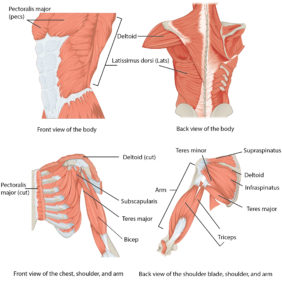
Muscles in the chest, upper back, shoulders, and arms that are used in propelling a wheelchair.17
When pushing a manual wheelchair, many muscles in the upper back, chest, shoulder, and arms are used. Pushing a manual wheelchair is not the most efficient way of getting around, as only between 2-14% of force applied by the arms goes into propelling a wheelchair, depending on the level of injury and style of propelling. The shoulder muscles are particularly strained during wheelchair propulsion as they are relatively smaller muscles that are responsible for both stabilizing the shoulder and applying force to a wheelchair to push it forward . Shoulder pain occurs in 31-73% of manual wheelchair users, and weak evidence suggests that individuals with tetraplegia experience more pain due to greater forces being applied with their arms.
Kinematics: the technique you use when propelling a wheelchair can impact your risk of shoulder pain/injury. For example, pushing a wheelchair at increasing speeds/intensities may contribute to the development of shoulder pain. Additional factors to be considered include the angle of your joints (i.e., the elbows, wrist) when pushing, and the angle at which you push your tires at.
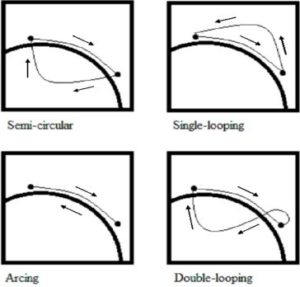 Propulsion pattern: the pattern you push your wheelchair with (e.g., where do your hands go when you push and after you’re done pushing) may also have an influence on your risk of injury. Some weak evidence suggests that using the semi-circular and double-loop-over may reduce the risk of nerve injury and are the most optimal ways to push your wheelchair. Further evidence (weak) has indicated that arcing may be more efficient for short bouts of high intensity pushing (like when going uphill).
Propulsion pattern: the pattern you push your wheelchair with (e.g., where do your hands go when you push and after you’re done pushing) may also have an influence on your risk of injury. Some weak evidence suggests that using the semi-circular and double-loop-over may reduce the risk of nerve injury and are the most optimal ways to push your wheelchair. Further evidence (weak) has indicated that arcing may be more efficient for short bouts of high intensity pushing (like when going uphill).
Body weight: Weak evidence suggests that having a higher body weight may be related to a higher risk of injury while propelling your wheelchair. This is due to the fact that moving a heavier body requires higher forces created by the shoulders. Body weight management is important in decreasing the amount of force created in your arms when pushing your wheelchair, and reduces the risk of injury.
Wheelchair set up: Having the rear wheels on a manual wheelchair placed in a forward axle position can help improve push rim biomechanics, reduce the amount of force put on your shoulders when propelling, and the frequency of propulsion (i.e., you do not have to push as much to go as far). Research has suggested the use of manual wheelchairs with adjustable axle positions so that the rear wheels can be optimally adjusted.
Wheeling on uneven surfaces: Some research suggests that wheeling across cross slopes (such as a driveway) can increase the forces on the arm and may lead to overuse injuries. In addition, more physiological effort (i.e., heart rate, how much oxygen is being used, rating of perceived exertion) is required to go up slopes more than 2% incline, and more physiological and physical effort is required to go up slopes greater than 8%.
Manual wheelchairs are highly customizable pieces of equipment that can be tailored to your needs. In order to optimally use your wheelchair, certain adjustments to the backrest, frame, and tires can be made. Using manual wheelchairs requires upper arm function and strength. Improper set ups and techniques may lead to injuries.
It is best to discuss all treatment options with your health providers to find out which treatments are suitable for you.
For a review of how we assess evidence at SCIRE Community and advice on making decisions, please see SCIRE Community Evidence.
Titus L, Moir S, Casalino A, McIntyre A, Connolly S, Mortenson B, Guilbalt L, Miles S, Trenholm K, Benton B, Regan M. (2016). Wheeled Mobility and Seating Equipment Following Spinal Cord Injury. In Eng JJ, Teasell RW, Miller WC, Wolfe DL, Townson AF, Hsieh JTC, Connolly SJ, Loh E, McIntyre A, editors. Spinal Cord Injury Rehabilitation Evidence. Version 6.0: p 1-178.
Available from: https://scireproject.com/evidence/rehabilitation-evidence/wheeled-mobility-and-seating-equipment/
Evidence for “What are the components of a manual wheelchair?” is based on:
Boninger, M., and the Model Systems Knowledge Translation Center. (2019). The manual wheelchair: What the spinal cord injury consumer needs to know. Retrieved from: https://msktc.org/sci/factsheets/wheelchairs/The-Manual-Wheelchair
Spinal outreach team and The University of Queensland School of health and rehabilitation sciences. (n.d.). Manual wheelchairs: Information resource for service providers. Retrieved from: https://www.health.qld.gov.au/__data/assets/pdf_file/0026/429911/manual-wheelchairs.pdf
Evidence for “What adjustments can I make to my manual wheelchair?” is based on:
Sprigle, S. (2014). Measure it: proper wheelchair fit is key to ensuring function while protecting skin integrity. Advanced Skin Wound Care, 27(12), 561-72.
Evidence for “What are health concerns related to manual wheelchair use?” is based on:
Arva, J., Fitzgerald, S. G., Cooper, R. A., & Boninger, M. L. (2001). Mechanical efficiency and user power requirement with a pushrim activated power assisted wheelchair. Medical Engineering and Physics, 23(10), 699–705. https://doi.org/10.1016/S1350-4533(01)00054-6
Boninger, M. L., Souza, A. L., Cooper, R. A., Fitzgerald, S. G., Koontz, A. M., & Fay, B. T. (2002). Propulsion patterns and pushrim biomechanics in manual wheelchair propulsion. Archives of Physical Medicine and Rehabilitation, 83(5), 718–723. https://doi.org/10.1053/apmr.2002.32455
Curtis, K. A., Drysdale, G. A., Lanza, R. D., Kolber, M., Vitolo, R. S., & West, R. (1999). Shoulder pain in wheelchair users with tetraplegia and paraplegia. Archives of Physical Medicine and Rehabilitation, 80(4), 453–457. https://doi.org/10.1016/S0003-9993(99)90285-X
Gil-Agudo, A., Del Ama-Espinosa, A., Pérez-Rizo, E., Pérez-Nombela, S., & Pablo Rodríguez-Rodríguez, L. (2010). Upper limb joint kinetics during manual wheelchair propulsion in patients with different levels of spinal cord injury. Journal of Biomechanics, 43(13), 2508–2515. https://doi.org/10.1016/j.jbiomech.2010.05.021
Kulig, K., Newsam, C. J., Mulroy, S. J., Rao, S., Gronley, J. K., Bontrager, E. L., & Perry, J. (2001). The effect of level of spinal cord injury on shoulder joint kinetics during manual wheelchair propulsion. Clinical Biomechanics, 16, 744–751.
Rankin, J. W., Richter, W. M., & Neptune, R. R. (2011). Individual muscle contributions to push and recovery subtasks during wheelchair propulsion. Journal of Biomechanics, 44(7), 1246–1252. https://doi.org/10.1016/j.jbiomech.2011.02.073
Richter, W. M., Rodriguez, R., Woods, K. R., & Axelson, P. W. (2007). Consequences of a Cross Slope on Wheelchair Handrim Biomechanics. Archives of Physical Medicine and Rehabilitation, 88(1), 76–80. https://doi.org/10.1016/j.apmr.2006.09.015
Image credits
- Kuschall wheelchair model R33 ©Tim99~commonswiki, CC BY-SA 4.0
- Image modified from Different kinds of handicap equipments ©brgfx, Freepik License
- Wheelchair ©George Hodan, CC0 1.0
- Wheelchair parts (main pic) ©Memasa CC BY-SA 3.0
- The SCIRE Community Team
- Modified from disabled, stroller, the disease, wheelchair, disability, wheel, transportation, medical equipment, metal, mode of transportation, CC0 1.0
- Wheelchair disability paraplegic injured disabled ©stevepb, Pixabay License
- wheelchair, old, vintage, isolated, wheel, antique, transportation, white, retro, transport, CC0 1.0
- The SCIRE Community Team
- Wheelchair disabled person with reduced mobility man ©SGENET, Pixabay License
- Forward versus trailing casters ©Ian Denison
- Modified from Black and grey wheelchair, CC0 1.0
- Woman, dog, pet, friend, outdoors, grass, female, person, jacket, pal, CC0 1.0
- Axle Position by the SCIRE Community Team
- Modified from Disabled people set Free Vector ©Macrovector, Freepik License
- Euroleague – LE Roma vs Toulouse IC-27 ©Pierre-Selim, CC BY-SA 3.0
- Muscles that move the humerus ©Betts et al, CC BY-SA 4.0
- Stylized illustration of stroke pattern classification during wheelchair propulsion ©Emily Churton and Justin WL Keogh, CC BY 2.0





